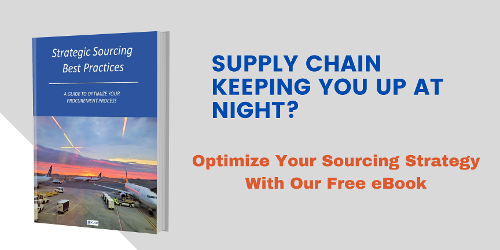When the US-China trade war broke out in 2018, many were surprised. Prior to the outbreak, the two...
How Should Buyers Deal With Price Increases?
Inflation has been the hot button issue over the past couple months. It will likely be the main topic of discussion in the months to come. Consequently, it is important to understand the nature and causes of inflation.
In this week’s article we will explore the following causes of inflation: Lax monetary policy, changes to supply and/or demand, and expectations. We will also explore how buyers should respond to price increases.
%20(1).png?width=600&name=Untitled%20(600%20%C3%97%20350%20px)%20(1).png)
Background
Inflation sees the price of goods increase and the value of money decrease. As a result, recent increases in inflation rates have made everyone’s life all the more difficult. Of course, this is not the first time this has happened. According to the White House, there were six major episodes of inflation post-Great Depression.
The first occurred after WWII (~20%), the second after the Korean War (~10%), and the third in the 1960s (~8%). The fourth took place during the 1970s oil shocks (~15%) while the fifth took place after the invasion of Kuwait (~8%). The sixth was brought about by the housing market crash and the resulting 2008 Global Financial Crisis (~7%).
Lax Monetary Policy
There may be instances in which Central Banks would relax monetary policy. However, this has its own ramifications. According to the Quantity Theory of Money, the larger the supply of money in circulation the greater the inflation and vice versa, writes the European Central Bank. Central banks have different instruments to ease monetary policy. Interests are one such instrument.
Many central banks, including the US Federal Reserve and the European Central Bank, have lowered and raised interest rates again following the COVID-19-induced economic crisis to promote greater economic growth, reports CNBC and a different article by CNBC.
Quantitative easing another instrument. According to Forbes, QE involves central banks buying securities to drive down interest rates and increase supply of cash in circulation. According to Reuters, QE was extensively used by the Bank of England during the pandemic.
Changes in Supply and/or Demand
As we have established in previous articles, global supply chains were heavily disrupted and delayed by the pandemic. Consequently, certain goods were in short supply despite demand remaining the same or even increasing, as is the case with semiconductors.
The sudden outbreak of the Ukraine War and the degrading climate crisis has only worsened supply shortages, especially when it comes to certain agricultural products. However, where global shocks can cause supply shortages they can also affect demand.
More specifically, they can induce excess demand. For example, the semiconductor shortage during the initial phases of the pandemic led to a sudden spike in demand in the months after as factories that were once closed reopened again and faced greater numbers of orders then compared to when they closed factories.
Expectations
Expectations can seriously affect markets. There is the easy example of investor paranoia and the resulting stock market crashes. There is also the example of the wage-price spiral. Forbes defines the spiral and its different stages as such:
“1) Companies boost pay to hold onto workers and hire new ones in a tight labor market; 2) Companies raise prices to pass on their higher costs — including worker pay increases — to consumers; 3) Consumers demand higher wages so they can keep up with higher prices; and 4) Return to step 1.:”
We are currently in the middle of a possible wage-price spiral according to many analysts. Reuters reports that the current inflation-induced spiral is in fact the rationale behind why many central banks raised interest rates. However, this thinking has come under scrutiny by many who argue that labour markets are not as tight as initially thought of.
Buyer Response to Price Increases
Buyers can adopt several responses to price increase. First, buyers can bundle products together. This means buyers would negotiate with suppliers to purchase several products together but at a lower cost than purchasing products separately, writes Investopedia.
Second, buyers can request a more detailed cost breakdown from suppliers as a means to understand how and why prices of purchased goods increased or are likely to increase. The breakdown should include, at a minimum, labour costs, material costs, shipping costs, etc.
Third, buyers can negotiate for lower prices and adjust the frequency of their orders (Though, likely more applicable for long-term suppliers). The theory being that it is preferable to have larger, less frequent bulk orders. Fourth, buyers can adjust product specs, lowering the costs of production.
Lastly, they can negotiate for better payment terms. For example, payments can be made in instalments going forward, as opposed to a lump sum. However, this is all of course contingent on the express consent of all parties, especially the suppliers.
Conclusion
In conclusion, price increases can occur due to many different reasons, though inflation is often a primary cause. Once inflation starts it can be very difficult to stop it. Once it starts, it is sure to have many other ramifications, such as the wage-price spiral.
Evidently, there is no easy or quick solution to this mess. However, we here at Kusu believe that we all have a part to play in easing this mess. Kusu's manufacturing partners are the epitome of transparency and cooperation, doing their best to help keep prices under control.
-1.jpg?width=146&height=50&name=Kusu%20(1)-1.jpg)

-1.png?height=200&name=Untitled%20design%20(25)-1.png)

